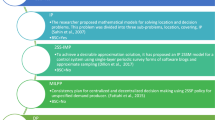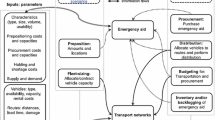Abstract
In the aftermath of a disaster, acquiring and fulfilling blood demand is essential to prevent further loss of lives. Consequently, in recent years, the concept of blood supply chain design for disaster relief has gained immense importance. This article addresses this issue by developing a novel bi-objective scenario-based mathematical model to minimize the system’s costs while enhancing the blood supply rate. The proposed framework encompasses three echelons of blood centers, hospitals, and backup blood centers. The model is developed using a set of techniques, including backup coverage, lateral transshipment, gift card, buffer storage, and blood transfusion. This specific combination aims to reduce blood shortages in the system by improving the coordination among different echelons of the network and encouraging more eligible individuals to donate blood. Next, the model is evaluated by applying it to a case study concerning a probable dangerous earthquake in Tehran capital of Iran. Furthermore, a Lagrangian relaxation method is implemented on the model to improve its capability in dealing with larger-scale problems with higher efficiency. Finally, the results and analysis demonstrate our approach’s validity and advantages in satisfying the blood demand in a disaster time.










Similar content being viewed by others
References
Abbaspour A, Jahan A, Rezaiee M (2020) A simple empirical model for blood platelet production and inventory management under uncertainty. J Ambient Intell Hum Comput 12:1783–1799
Abolghasemi H, Hosseini-Divkalayi NS, Seighali F (2010) Blood donor incentives: a step forward or backward. Asian J Transfus Sci 4(1):9
American Red Cross (2020) https://redcrosschat.org/2020/01/13/blood-donation-was-my-rite-of-passage/. Accessed 1 Sept 2020
American Red Cross (2021) https://www.gainesvilletimes.com/news/health-care/red-cross-offers-amazon-gift-cards-blood-donations/.
Ara AL, Kazemi A, Gahramani S, Behshad M (2012) Optimal reactive power flow using multi-objective mathematical programming. Scie Iran 19(6):1829–1836
Banthao J, Jittamai P (2012) An analysis of alternative blood bank locations with emergency referral. In: Proceedings of the World Congress on engineering and computer science 2: 24–26
Baş S, Carello G, Lanzarone E, Yalçındağ S (2018) An appointment scheduling framework to balance the production of blood units from donation. Eur J Oper Res 265(3):1124–1143
Belien J, Force H (2012) Supply chain management of blood products: a literature review. Eur J Oper Res 217(1):1–16
Brandeau ML, Sainfort F, Pierskalla WP (2004) Operations research and health care: a handbook of methods and applications. 70. Springer Science & Business Media
Cheraghi S, Hosseini-Motlagh SM (2020) Responsive and reliable injured-oriented blood supply chain for disaster relief: a real case study. Ann Oper Res 291(1):129–167
Dehghani M, Abbasi B (2018) An age-based lateral-transshipment policy for perishable items. Int J Prod Econ 198:93–103
Dehghani M, Abbasi B, Oliveira F (2021) Proactive transshipment in the blood supply chain: a stochastic programming approach. Omega 98:102112
Dillon M, Oliveira F, Abbasi B (2017) A two-stage stochastic programming model for inventory management in the blood supply chain. Int J Prod Econ 187:27–41
Doocy S, Daniels A, Packer C, Dick A, Kirsch, TD (2013) The human impact of earthquakes: a historical review of events 1980–2009 and systematic literature review. PLoS Curr, p 5
Drackley A, Newbold KB, Paez A, Heddle N (2012) Forecasting Ontario’s blood supply and demand. Transfusion 52:366–374
Duan Q, Liao TW (2014) Optimization of blood supply chain with shortened shelf lives and ABO compatibility. Int J Prod Econ 153:113–129
Einali J, Mohamady Yeganeh B, Cheraghi M, Feyzolahpour M (2020) Evaluating the effects of reconstruction of the damaged villages in the 2002 earthquake in Avaj, Iran. Int J Disaster Risk Reduct 43:101373
Ensafian H, Yaghoubi S (2017) Robust optimization model for integrated procurement, production and distribution in platelet supply chain. Transport Res Part E: Log Transport Rev 103:32–55
Fahimnia B, Jabbarzadeh A, Ghavamifar A, Bell M (2017) Supply chain design for efficient and effective blood supply in disasters. Int J Prod Econ 183:700–709
Fan X, Nie G, Deng Y, An J, Zhou J, Xia Ch, Pang X (2019) Estimating earthquake-damage areas using Landsat-8 OLI surface reflectance data. Int J Disaster Risk Reduct 33:275–283
Fisher ML (2004) The Lagrangian relaxation method for solving integer programming problems. Managt Sci 50(12_supplement):1861–1871
Gunpinar S, Centeno G (2015) Stochastic integer programming models for reducing wastages and shortages of blood products at hospitals. Comput Oper Res 54:129–141
Haeri A, Hosseini-Motlagh SM, Samani MRGH, Rezaei MS (2020) A bi-level programming approach for improving relief logistics operations: a real case in Kermanshah earthquake. Comput Ind Eng 145:106532
Haghani A, Afshar AM (2009) Supply chain management in disasters, Final Project Report, Mid-Atlantic Universities Transportation Center.
Haghjoo N, Tavakkoli-Moghaddam R, Shahmoradi-Moghadam H, Rahimi Y (2020) Reliable blood supply chain network design with facility disruption: a real-world application. Eng Appl Artif Intell 90:103493
Haimes Y (1971) On a bicriterion formulation of the problems of integrated system identification and system optimization. IEEE Trans Syst Man Cybern 1(3):296–297
Hamdan B, Diabat A (2019) A two-stage multi-echelon stochastic blood supply chain problem. Comput Oper Res 101:130–143
Hamdan B, Diabat A (2020) Robust design of blood supply chains under risk of disruptions using Lagrangian relaxation. Transport Res Part E 134:101764
Hatefi SM, Jolai F (2014) Robust and reliable forward–reverse logistics network design under demand uncertainty and facility disruptions. Appl Math Model 38(9–10):2630–2647
Hemmelmayr V, Doerner K, Hartl R, Savelsbergh M (2010) Vendor managed inventory for environments with stochastic product usage. Eur J Oper Res 202(3):686–695
Hess JR, Thomas MJ (2003) Blood use in war and disaster: lessons from the past century. Transfusion 43(11):1622–1633
Hinojosa Y, Kalcsics J, Nickel S, Puerto J, Velten S (2008) Dynamic supply chain design with inventory. Comput Oper Res 35(2):373–391
Holland L (2006) Role of ABO and Rh type in platelet transfusion. Lab Med 37(12):758–760
Hosseinifard Z, Abbasi B (2018) The inventory centralization impacts on sustainability of the blood supply chain. Comput Oper Res 89:206–212
Hosseini-Motlagh SM, Samani MRG, Cheraghi S (2020a) Robust and stable flexible blood supply chain network design under motivational initiatives. Socio-Econ Plang Sci 70:100725
Hosseini-Motlagh SM, Samani MRG, Homaei S (2020b) Blood supply chain management: robust optimization, disruption risk, and blood group compatibility (a real-life case). J Ambient Intell Humaniz Comput 11(3):1085–1104
Iranian Blood Transfusion Organization (2020) RBC Transfusion in clinical practice. https://en.ibto.ir/. Accessed 1 Dec 2020
Jabbarzadeh A, Fahimnia B, Seuring S (2014) Dynamic supply chain network design for the supply of blood in disasters: a robust model with real world application. Transport Res Part E Log Transport Rev 70:225–244
JICA C (2000) The study on seismic microzoning of the Greater Tehran Area in the Islamic Republic of Iran. In: Pacific Consultants International Report. OYO Cooperation, Japan, pp 291–390
Karadağ İ, Keskin ME, Yiğit V (2021) Re-design of a blood supply chain organization with mobile units. Soft Comput 25(8):6311–6327
Kasraian L, Maghsudlu M (2012) Blood donors’ attitudes towards incentives: influence on motivation to donate. Blood Transfus 10(2):186
Khalilpourazari S, Soltanzadeh S, Weber GW, Roy SK (2020) Designing an efficient blood supply chain network in crisis: neural learning, optimization and case study. Ann Oper Res 289(1):123–152
Kopach R, Balcioglu B, Carter M (2008) Tutorial on constructing red blood cell inventory management system with two demand rates. Eur J Oper Res 185(3):1051–1059
Kuruppu KKS (2010) Management of blood system in disasters. Biologicals 38(1):87–90
Lang DJC (2010) Blood bank inventory control with transshipments and substitutions. In: Lang JC (ed) Production and inventory management with substitutions. Springer, Berlin, Heidelberg, pp 205–226
Mavrotas G (2009) Effective implementation of the ε-constraint method in multi-objective mathematical programming problems. Appl Math Comput 213(2):455–465
Mena C, Humphries A, Wilding R (2009) A comparison of inter-and intra-organizational relationships. Int J Phys Distrib Log Manag 39:762–784
Mohamadi A, Yaghoubi S (2017) A bi-objective stochastic model for emergency medical services network design with backup services for disasters under disruptions: an earthquake case study. Int J Disaster Risk Reduct 23:204–217
Nagurney A, Masoumi AH, Yu M (2012) Supply chain network operations management of a blood banking system with cost and risk minimization. CMS 9(2):205–231
Nahmias S (1982) Perishable inventory theory: a review. Oper Res 30(4):680–708
Nahofti Kohneh J, Teymoury E, Pishvaee MS (2016) Blood products supply chain design considering disaster circumstances (Case study: earthquake disaster in Tehran). J Ind Syst Eng 9:51–72
Najafi M, Ahmadi A, Zolfagharinia H (2018) Blood inventory management in hospitals: considering supply and demand uncertainty and blood transshipment possibility. Oper Res Health Care 15:43–56
Osorio AF, Brailsford SC, Smith HK (2015) A structured review of quantitative models in the blood supply chain: a taxonomic framework for decision-making. Int J Prod Res 53(24):7191–7212
Osorio AF, Brailsford SC, Smith HK, Forero-Matiz SP, Camacho-Rodríguez BA (2017) Simulation-optimization model for production planning in the blood supply chain. Health Care Manag Sci 20(4):548–564
Osorio AF, Brailsford SC, Smith HK (2018) Whole blood or apheresis donations? A multi-objective stochastic optimization approach. Eur J Oper Res 266(1):193–204
Özener OÖ, Ekici A, Coban E (2019) Improving blood products supply through donation tailoring. Comput Oper Res 102:10–21
Pouraliakbari-Mamaghani M, Ghodratnama A, Pasandideh SHR, Saif A (2021) A robust possibilistic programming approach for blood supply chain network design in disaster relief considering congestion. Oper Res, pp 1–46
Puranam K, Novak D, Lucas M, Fung M (2017) Managing blood inventory with multiple independent sources of supply. Eur J Oper Res 259(2):500–511
Remy KE, Spinella PC (2016) Red blood cell storage age - what we know from clinical trials. Expert Rev Hematol 9(11):1011–1013
Şahin G, Sural H, Meral S (2007) Locational analysis for regionalization of Turkish Red Crescent blood services. Comput Oper Res 34(3):692–704
Samani MRG, Hosseini-Motlagh SM (2021) A novel capacity sharing mechanism to collaborative activities in the blood collection process during the COVID-19 outbreak. Appl Soft Comput 112:107821
Samani MRGh, Torabi SA, Hosseini-Motlagh SM (2019) An enhanced procedure for managing blood supply chain under disruptions and uncertainties. Ann Oper Res 283(1):1413–1462
Schulz SF, Blecken A (2010) Horizontal cooperation in disaster relief logistics: benefits and impediments. Int J Phys Distrib Logistics Manage 40:636–656
Schultz CH, Koenig KL, Noji EK (1996) A medical disaster response to reduce immediate mortality after an earthquake. N Engl J Med 334(7):438–444
Seyfi-Shishavan SA, Donyatalab Y, Farrokhizadeh E, Satoglu SI (2021) A fuzzy optimization model for designing an efficient blood supply chain network under uncertainty and disruption. Ann Oper Res, pp 1–55
Sha Y, Huang J (2012) The multi-period location-allocation problem of engineering emergency blood supply systems. Syst Eng Proc 5:21–28
Van Zyl GJ (1963) Inventory control for perishable commodities. North Carolina State University, Dept. of Statistics
Wang Ch, Chen Sh (2020) A distributionally robust optimization for blood supply network considering disasters. Transport Res Part E 134:101840
Wang Y, Zhang Y, Zhao L, Yin Y, Wang Q, Zhou H (2014) Addition of haptoglobin to RBCs storage, a new strategy to improve quality of stored RBCs and transfusion. Med Hypotheses 82(2):125–128
WHO (World Health Organization) (2010) Prevention and Control of Noncommunicable Diseases: Implementation of the Global Strategy. Sixty-Third World Health Assembly, Report by the Secretariat.
Yaghoubi S, Hosseini-Motlagh SM, Cheraghi S, Larimi NG (2020) Designing a robust demand-differentiated platelet supply chain network under disruption and uncertainty. J Ambient Intell Humaniz Comput 11(8):3231–3258
Yariyan P, Zabihi H, Wolf ID, Karami M, Amiriyan S (2020) Earthquake risk assessment using an integrated Fuzzy Analytic Hierarchy Process with Artificial Neural Networks based on GIS: A case study of Sanandaj in Iran. Int J Disaster Risk Reduct 50:101705
Zahiri B, Torabi SA, Mousazadeh M, Mansouri SA (2015) Blood collection management: methodology and application. Appl Math Model 39(23–24):7680–7696
Author information
Authors and Affiliations
Corresponding author
Additional information
Publisher's Note
Springer Nature remains neutral with regard to jurisdictional claims in published maps and institutional affiliations.
Rights and permissions
About this article
Cite this article
Nahofti Kohneh, J., Derikvand, H., Amirdadi, M. et al. A blood supply chain network design with interconnected and motivational strategies: a case study. J Ambient Intell Human Comput 14, 8249–8269 (2023). https://doi.org/10.1007/s12652-021-03594-y
Received:
Accepted:
Published:
Issue Date:
DOI: https://doi.org/10.1007/s12652-021-03594-y




